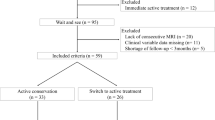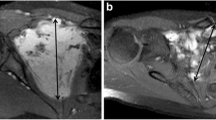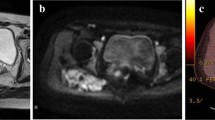Abstract
Objectives
To propose a follow-up strategy for desmoid-type fibromatosis (DF) based on tumor growth behavior and the signal on T2-weighted MRI.
Methods
We retrospectively reviewed 296 MRI studies of 34 patients with histologically proven DF. In each study, tumor volume and T2 signal relatively normal striated muscle were assessed. Volume variation and monthly growth rates were analyzed to determine lesion growth behavior (progressing versus stable/regressing lesions). Growth behavior was correlated with T2 signal, tumor location, β-catenin status, treatment strategy, and follow-up duration. Interobserver variability of volume measurements and interobserver measurement variation ratio were assessed.
Results
There were 25 women and 9 men with a mean age of 39.9 ± 19 (4–73) years. Mean follow-up time in the patients included was 55 ± 41 (12–148) months. In progressing lesions, the mean average monthly growth ratio was 10.9 ± 9.2 (1.1–42.5) %. Interobserver variability of volume measurements was excellent (ICC = 0.96). Mean interobserver measurement variation ratio was 20.4 ± 23.6%. The only factor correlated with tumor growth behavior was T2 signal ratio (p < 0.0001). Seventeen out of 34 (50%) patients presented a signal change over the threshold of 1 during follow-up. There were five occurrences of secondary growth after a period of stability with a mean delay until growth of 38.2 ± 44.2 (17–116) months.
Conclusion
DF growth rate was quantitatively assessed. A threshold for volume variation detection was established. DF growth behavior was significantly related to T2 signal. An evidence-based follow-up strategy is proposed.
Key Points
• In progressing desmoid fibromatosis, the mean average monthly growth ratio was 10.9 ± 9.2%.
• Lesions with muscle/tumor T2 signal ratios lower than 1 tended to be stable or regress over time.
• Given the interobserver measurement variability and MRI in-plane spatial resolution, a variation higher than 42.6% in tumor volume is required to confirm punctual progression.




Similar content being viewed by others
Abbreviations
- AMGR:
-
Average monthly growth rate
- CI:
-
Confidence intervals
- DF:
-
Desmoid-type fibromatosis
- ETL:
-
Echo train length
- FOV:
-
Field-of-view
- ICC:
-
Intraclass correlation coefficients
- MRI:
-
Magnetic resonance imaging
- NEX:
-
Number of excitations
- TE:
-
Echo time
- TR:
-
Repetition time
References
Fletcher CDM, Unni KK, Mertens F (2002) Pathology and genetics of tumours of soft tissue and bone. IARC Press, Lyon, France, April 24 - 28, 2002. IARC Press, Lyon
Salas S, Dufresne A, Bui B et al (2011) Prognostic factors influencing progression-free survival determined from a series of sporadic desmoid tumors: a wait-and-see policy according to tumor presentation. J Clin Oncol 29:3553–3558 https://doi.org/10.1200/JCO.2010.33.5489
Shields CJ, Winter DC, Kirwan WO, Redmond HP (2001) Desmoid tumours. Eur J Surg Oncol 27:701–706 https://doi.org/10.1053/ejso.2001.1169
Gronchi A, Colombo C, Le Péchoux C et al (2014) Sporadic desmoid-type fibromatosis: a stepwise approach to a non-metastasising neoplasm—a position paper from the Italian and the French Sarcoma Group. Ann Oncol 25:578–583 https://doi.org/10.1093/annonc/mdt485
Bonvalot S, Desai A, Coppola S et al (2012) The treatment of desmoid tumors: a stepwise clinical approach. Ann Oncol 23:x158–x166 https://doi.org/10.1093/annonc/mds298
Bonvalot S, Rimareix F, Causeret S et al (2009) Hyperthermic isolated limb perfusion in locally advanced soft tissue sarcoma and progressive desmoid-type fibromatosis with TNF 1 mg and melphalan (T1-M HILP) is safe and efficient. Ann Surg Oncol 16:3350–3357 https://doi.org/10.1245/s10434-009-0733-9
Shinagare AB, Ramaiya NH, Jagannathan JP et al (2011) A to Z of desmoid tumors. AJR Am J Roentgenol 197:W1008–W1014 https://doi.org/10.2214/AJR.11.6657
Kujak JL, Liu PT, Johnson GB, Callstrom MR (2010) Early experience with percutaneous cryoablation of extra-abdominal desmoid tumors. Skeletal Radiol 39:175–182 https://doi.org/10.1007/s00256-009-0801-z
Grimer R, Judson I, Peake D, Seddon B (2010) Guidelines for the management of soft tissue sarcomas. Sarcoma 2010:1–15 https://doi.org/10.1155/2010/506182
Kasper B, Baumgarten C, Bonvalot S et al (2015) Management of sporadic desmoid-type fibromatosis: a European consensus approach based on patients’ and professionals’ expertise – a Sarcoma Patients EuroNet and European Organisation for Research and Treatment of Cancer/Soft Tissue and Bone Sarcoma Group initiative. Eur J Cancer 51:127–136 https://doi.org/10.1016/j.ejca.2014.11.005
Eastley N, Hennig IM, Esler CP, Ashford RU (2014) 99. Nationwide trends in the current management of desmoid (aggressive) fibromatosis. Eur J Surg Oncol 40:S47 https://doi.org/10.1016/j.ejso.2014.08.095
Gondim Teixeira PA, Chanson A, Verhaeghe JL et al (2019) Correlation between tumor growth and hormonal therapy with MR signal characteristics of desmoid-type fibromatosis: a preliminary study. Diagn Interv Imaging 100:47–55 https://doi.org/10.1016/j.diii.2018.06.007
Castellazzi G, Vanel D, Le Cesne A et al (2009) Can the MRI signal of aggressive fibromatosis be used to predict its behavior? Eur J Radiol 69:222–229 https://doi.org/10.1016/j.ejrad.2008.10.012
de Camargo VP, Keohan ML, D’Adamo DR, et al (2010) Clinical outcomes of systemic therapy for patients with deep fibromatosis (desmoid tumor). Cancer 116:2258–2265 https://doi.org/10.1002/cncr.25089
Aghighi M, Boe J, Rosenberg J et al (2016) Three-dimensional radiologic assessment of chemotherapy response in Ewing sarcoma can be used to predict clinical outcome. Radiology 280:905–915 https://doi.org/10.1148/radiol.2016151301
Stacchiotti S, Collini P, Messina A et al (2009) High-grade soft-tissue sarcomas: tumor response assessment—pilot study to assess the correlation between radiologic and pathologic response by using RECIST and Choi criteria. Radiology 251:447–456 https://doi.org/10.1148/radiol.2512081403
Cassidy MR, Lefkowitz RA, Long N et al (2018) Association of MRI T2 signal intensity with desmoid tumor progression during active observation: a retrospective cohort study. Ann Surg:1 https://doi.org/10.1097/SLA.0000000000003073
Mozley PD, Bendtsen C, Zhao B et al (2012) Measurement of tumor volumes improves RECIST-based response assessments in advanced lung cancer. Transl Oncol 5:19–25 https://doi.org/10.1593/tlo.11232
Krajewski KM, Nishino M, Franchetti Y, Ramaiya NH, Van den Abbeele AD, Choueiri TK (2014) Intraobserver and interobserver variability in computed tomography size and attenuation measurements in patients with renal cell carcinoma receiving antiangiogenic therapy. Cancer 120:711–721 https://doi.org/10.1002/cncr.28493
Schwartz LH, Litière S, de Vries E, et al (2016) RECIST 1.1 – update and clarification: from the RECIST committee. Eur J Cancer 62:132–137. https://doi.org/10.1016/j.ejca.2016.03.081
Sheth PJ, del Moral S, Wilky BA et al (2016) Desmoid fibromatosis: MRI features of response to systemic therapy. Skeletal Radiol 45:1365–1373 https://doi.org/10.1007/s00256-016-2439-y
Burke M, Anderson JR, Kao SC et al (2007) Assessment of response to induction therapy and its influence on 5-year failure-free survival in group III rhabdomyosarcoma: the Intergroup Rhabdomyosarcoma Study-IV experience—a report from the Soft Tissue Sarcoma Committee of the Children’s Oncology Group. J Clin Oncol 25:4909–4913 https://doi.org/10.1200/JCO.2006.10.4257
Bissler JJ, McCormack FX, Young LR et al (2008) Sirolimus for angiomyolipoma in tuberous sclerosis complex or lymphangioleiomyomatosis. N Engl J Med 358:140–151
Dangoor A, Seddon B, Gerrand C, Grimer R, Whelan J, Judson I (2016) UK guidelines for the management of soft tissue sarcomas. Clin Sarcoma Res 6. https://doi.org/10.1186/s13569-016-0060-4
Havaei M, Davy A, Warde-Farley D et al (2017) Brain tumor segmentation with deep neural networks. Med Image Anal 35:18–31 https://doi.org/10.1016/j.media.2016.05.004
Acknowledgements
We are indebted to Dr. Jean-Luc Verhaeghe for the support in the preparation of this work.
Funding
The authors state that this work has not received any funding.
Author information
Authors and Affiliations
Corresponding author
Ethics declarations
Guarantor
The scientific guarantor of this publication is Professor Alain Blum.
Conflict of interest
The authors of this manuscript declare no relationships with any companies, whose products or services may be related to the subject matter of the article.
Statistics and biometry
One of the authors has significant statistical expertise.
Informed consent
Written informed consent was waived by the Institutional Review Board.
Ethical approval
Institutional Review Board approval was not required because retrospective studies with fully anonymized patient data do not require ethics committee approval.
Methodology
• retrospective
• observational
• performed at one institution
Additional information
Publisher’s note
Springer Nature remains neutral with regard to jurisdictional claims in published maps and institutional affiliations.
Rights and permissions
About this article
Cite this article
Gondim Teixeira, P.A., Biouichi, H., Abou Arab, W. et al. Evidence-based MR imaging follow-up strategy for desmoid-type fibromatosis. Eur Radiol 30, 895–902 (2020). https://doi.org/10.1007/s00330-019-06404-4
Received:
Revised:
Accepted:
Published:
Issue Date:
DOI: https://doi.org/10.1007/s00330-019-06404-4




